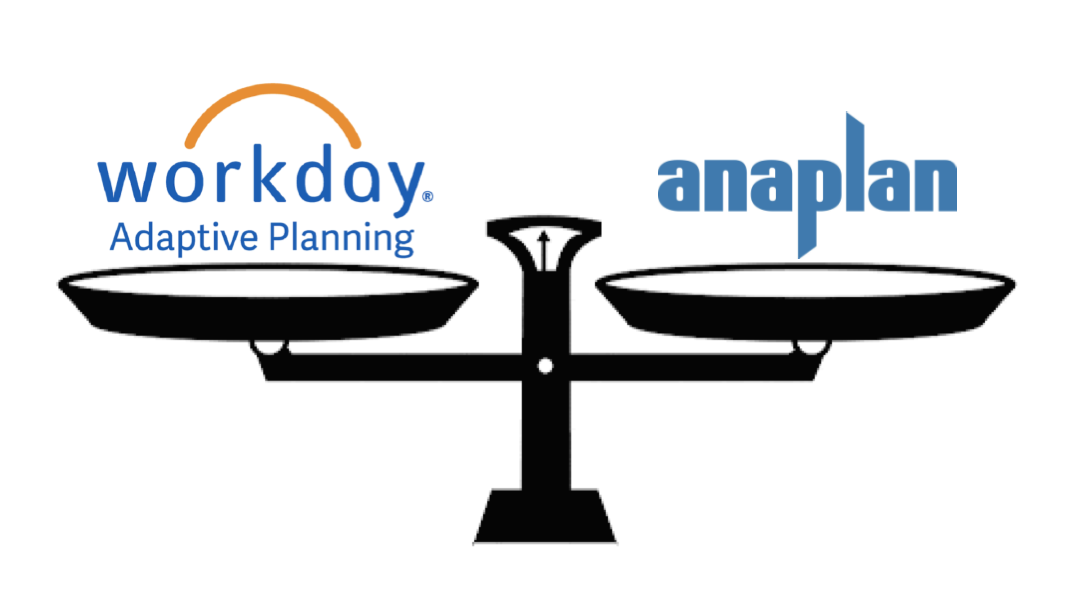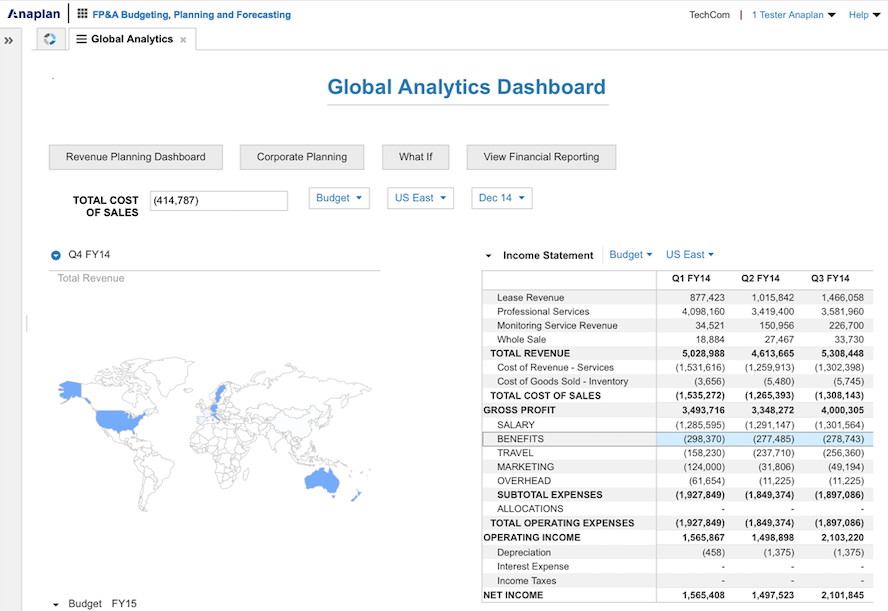
Table of contents
An overview of Workday vs. Anaplan CPM software solutions
Anaplan and Workday Adaptive Planning are both Corporate Performance Management (CPM) products that specialize in budgeting and financial planning. Workday Adaptive Planning is the recognized leader in this industry, but Anaplan has been gaining more traction recently.
The right solution for your business is dependent on size and needs, so understanding the benefits and drawbacks of both is critical to make the optimal decision. First read our article, which explores the important features and value of any financial planning software to help you better understand what you should expect from your solution. For a more high-level look at corporate financial planning and analysis as a whole, check out our financial planning and analysis ultimate guide.
The two solutions reviewed in this article are most effective in different circumstances, both possessing their own advantages and disadvantages. We will get into the specifics of these differences below, so you can make a more informed decision on the best tool for your company.
Primary benefits
Anaplan
Anaplan is generally recognized as being helpful for large organizations. Reviewers point out the system’s adaptability to business and data structural changes, making its flexibility for scaling one of its main draws. Anaplan also has complex analysis features and strong data storage capabilities. It has the ability to run sophisticated what-if scenario modeling and allows many users to be synced with the system.
Workday Adaptive Planning
On the other hand, Workday Adaptive Planning is praised for its ease of use and support to customers. Traditionally, finance teams have used simple spreadsheet programs to manage their data and analyses, but our article explains why businesses are moving away from this practice.
Workday Adaptive Planning is sought after by a wider size range of companies: specifically expanding organizations, who have outgrown the capabilities of Excel, etc., but still want the straightforward and familiar interface. This minimizes the training curve for employees and guarantees a seamless implementation process, allowing the benefits of Workday Adaptive Planning to be leveraged almost immediately. If some users prefer or require additional training, Workday Adaptive Planning provides a large range of self-service resources for guidance and development. Source.
In addition to its convenience, Workday Adaptive Planning is superior in providing best-in-class visual results and content. With Workday Adaptive Planning, customized reports and deliverables can be quickly produced inside the program to drive home key findings. This content has proven extremely beneficial for financial analysts when preparing for board meetings to support their data-driven plans.

Common challenges or disadvantages
Anaplan
Although Anaplan has the potential to carry out a wide range of analyses, the program itself can be quite cumbersome so the value of these functions is often lost.
Many of these customized programs have to be built from scratch with complex coding, which greatly hinders the speed of scalability. This means Anaplan often struggles to keep up with the growth and changes of a quickly developing business. Furthermore, users have complained about the interface and the amount of necessary training, often taking a full year to sufficiently learn the program. Anaplan has also been criticized for a lack of training resources and support that users expect with a CPM vendor. Source.
Additionally, Anaplan lacks critical visualization capabilities which have become expected features of a competitive CPM. The dashboards and visual analyses do not meet the needs of most users nowadays, forcing them to rely on third-party tools. Source.
Workday Adaptive Planning
As stated above, these limitations with Anaplan are what sets Workday Adaptive Planning apart. It is extremely user friendly and scalable to your needs, offering powerful analysis and visual results.
Workday Adaptive Planning does not come without its flaws though. Compared to Anaplan, Workday Adaptive Planning systems are more limited when executing calculations on some large data sets. These differences are a minor result of the straightforward nature of Workday Adaptive Planning analysis tools, which require no coding and use simple English commands versus complicated Boolean logic.
Also, although Workday is praised for its straightforward interface, it is not an exact one to one match with excel in terms of functions and processes. Therefore, there may still be a bit of a learning curve for users during the transition. Fortunately, working with an experienced solution provider partner like QBIX Analytics, will ensure an efficient and effective implementation and guarantee your team fully equipt to take over the reins once completed.
Pricing & Time-to-value
In terms of pricing, both are highly variable and offer a variety of packages. Anaplan offers three tier levels of various storage sizes and functionality, while Workday Adaptive Planning offers two. However, on average Workday Adaptive Planning comes in at less than half the cost of Anaplan.
With Anaplan the storage levels are quite restrictive and it is easy to go over storage limits, causing subscription costs to quickly explode. This further hinders the productivity from the system, as many customers opt out of the higher trier plans due to financial concerns but this causes them to miss out on even more reporting and summary functionalities. Source.
Additionally, deployment time is crucial to compare. As time equates to money, quick implementation and set-up is undeniably valuable. With far more customers than Anaplan, Workday Adaptive Planning has developed best practices for efficient deployment, to reduce risk of delayed planning cycles.
Several customers have actually switched to Workday Adaptive Planning after spending at least a year attempting to deploy Anaplan without success. This process has not yet been streamlined and refined for Anaplan, the way it has been by Workday.
Conclusion: Choosing the right one for your business
While both tools offer distinct qualities, there is a reason more businesses choose Workday Adaptive Planning over any other CPM software provider. Although Anaplan has recently begun to gain more interest, Workday Adaptive Planning is still growing significantly faster and has a much wider range of clientele. Today, Workday Adaptive Planning’s customer base is nearly four times the size of Anaplan.
This vast difference can be attributed to the advantages of Workday Adaptive Planning that we have explored. Not only is it the more cost-effective solution, overall Workday Adaptive Planning is much more intuitive and customizable, allowing the full power of automation to be unleashed.
Are you ready to see how Workday Adaptive Planning can be seamlessly integrated into your business?